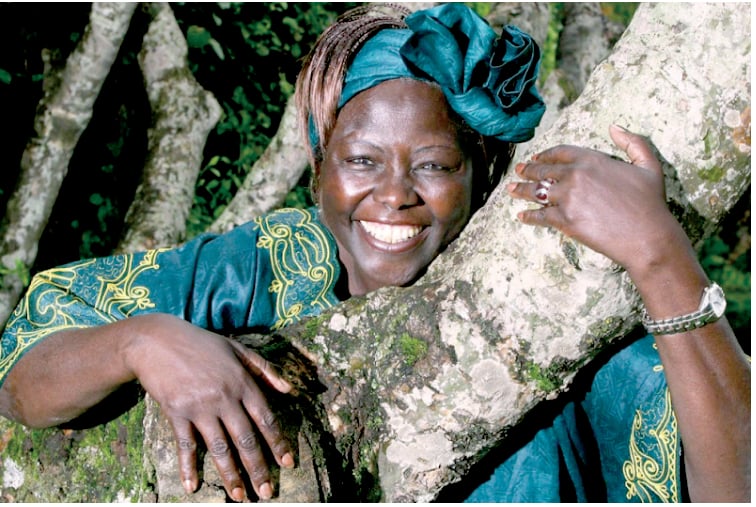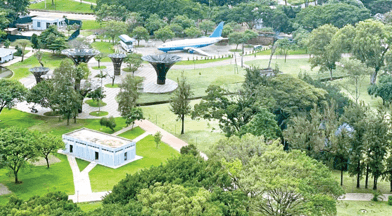The rise of Wangari Maathai landmarks

The iconic Wangari Maathai corner at Uhuru Park, Karura Forest Reserve and the lengthy Wangari Maathai Road (formerly Forest Road) are arguably pristine landmarks that continue to immortalise Kenya’s celebrated conservation warrior — the late Professor Wangari Maathai.
During weekends and holidays, Nairobians seeking rest from the city’s relentless pace, flock to these iconic green spaces to wind up and explore nature.
The stories of these landmarks often reflect a tapestry of struggle to reclaim natural resources, the quest for environmental justice, and the role of community-led forest conservation and corporate social responsibility. These spaces, now bustling with life and laughter, were not always guaranteed havens. But how did these two iconic green spaces come to reclaim their space as sanctuaries of urban peace?
Their stories overlap with Kenya’s fight for democracy, and environmental justice, and the tireless efforts of one celebrated and remarkable woman: The late Professor Wangari Maathai
Reclaiming Karura Forest In the late 1990s, Karura Forest, one of Nairobi’s few remaining indigenous forests, was threatened by deforestation and commercial development. Plans were underway to allocate sections of the land to private developers for construction projects. The proposed deforestation alarmed environmentalists, but few dared to challenge the powerful interests involved.
Wangari Maathai, Founder of the Green Belt Movement, emerged as the leading voice against the destruction. On January 8, 1999, she organized peaceful protests and led tree-planting campaigns to reclaim the forest. Despite facing police brutality and political backlash, Maathai remained steadfast.
“You cannot protect the environment unless you empower people,” she often said, rallying Kenyans to reclaim their right to public land. Her activism and determination would later pay off, sparking nationwide awareness of environmental issues and corruption in land allocation.
Public outcry, fuelled by her efforts, led the government to halt the developments inside the forest. It was once again; a win for the restoration of the indigenous forest—Karura Forest— was preserved, and it has since been transformed into a haven for nature lovers, joggers, and cyclists. Today, it boasts well-maintained trails, waterfalls, caves, and diverse wildlife, reflecting the success of community-driven conservation.
Battle for Uhuru Park While Karura Forest was a battle for nature, Uhuru Park became a battleground for democracy and the right to public space. Nestled in the heart of Nairobi, the park has long served as a gathering place for protests, rallies, and community events. But in 1989, it faced a big threat when plans emerged to construct a 60-storey business complex.
Maathai prolonged her resistance here too. She rallied Kenyans to oppose the development, emphasizing the environmental impact and the loss of public land. Her vocal opposition attracted international attention, drawing support from global environmental organisations. Despite facing personal threats, Maathai’s unwavering stance led to foreign investors cancelling the project.
The “Wangari Maathai Corner” that was established on October 8, 2011, at Freedom Corner in Uhuru Park following the death of Wangari Maathai now serves as both a memorial and a call to action.
Thriving green spaces The success of these green spaces over the decades is due to community commitment rather than just government or corporate support.
Local groups organize cleanups, tree planting, and environmental education. School children gain conservation knowledge through field trips, while youth groups utilise these areas for sports and art. Karura Forest has become a leading eco-tourism spot, promoting biodiversity and wellness for many visitors.
Uhuru Park, which reopened in March 2024 after renovations, remains a crucial recreational area, featuring modern landscaping, playgrounds, and accessible pathways. Aron Kecha, an urban planner and environmentalist, highlights Wangari Maathai’s significant contribution to environmentalism in Kenya through her advocacy for tree planting, which resonates with all citizens.
He notes that urban land scarcity often prioritises lucrative developments over green spaces, placing them at risk. Maathai actively fought against the alienation of these areas.
Thanks to her activism, Kenyans now value green spaces like the Arboretum, Karura Forest, and Uhuru Park, leading to stronger laws for their conservation.
However, increased land value has resulted in the encroachment and demand for luxury developments within these areas, threatening their ecological integrity Kecha emphasises that urban green spaces are vital for climate change adaptation and mitigation.
They serve as carbon sinks, lower urban temperatures, and help manage stormwater, thereby reducing the impacts of extreme weather events.















